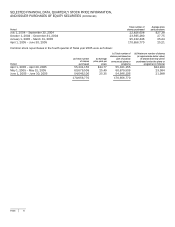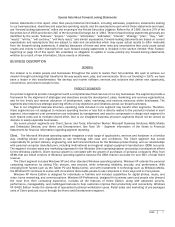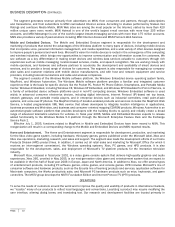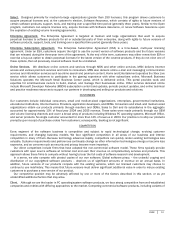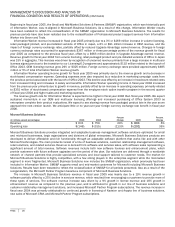Microsoft 2005 Annual Report Download - page 17
Download and view the complete annual report
Please find page 17 of the 2005 Microsoft annual report below. You can navigate through the pages in the report by either clicking on the pages listed below, or by using the keyword search tool below to find specific information within the annual report.
BUSINESS DESCRIPTION (CONTINUED)
PAGE 16
expected release in the first half of fiscal year 2006 of a new console, the Xbox 360. Sony and Nintendo have also announced
new versions of their game consoles. Success in this transition to the next generation of consoles depends on the
computational power of the console, the ease of developing games for the console, the ability to provide new revenue sources
such as advertising and downloadable content, and providing exclusive game content that is sought after by gamers. We believe
the Xbox 360 is positioned well against competitive console products based on significant innovation in the hardware
architecture, new developer tools, expanded revenue sources, and continued strong exclusive content from our 1st party game
franchises such as Halo.
In addition to competing against software published for non-Xbox platforms, our games business also competes with
numerous companies that have been licensed by us to develop and publish software for the Xbox console. These competitors
include Acclaim Entertainment, Activision, Atari, Capcom, Eidos, Electronic Arts, Sega, Take-Two Interactive, Tecmo, THQ, and
Ubi Soft, among others. Our PC hardware products face aggressive competition from computer and other hardware
manufacturers, many of which are also current or potential partners. Our MSTV business faces competition primarily from ad
hoc, point-solutions that address sub-segments of the TV delivery platform, but do not provide end-to-end solutions for the
network operator. Our largest MSTV competitors include IBM, Cisco, UTStarcom, and Siemens/Myrio.
RISK FACTORS
Challenges to our business model may reduce our revenues and operating margins. Our business model is based upon
customers agreeing to pay a fee to license software developed and distributed by us. Under this commercial software model,
software developers bear the costs of converting original ideas into software products through investments in research and
development, offsetting these costs with the revenue received from the distribution of their products. We believe the
commercial software model has had substantial benefits for users of software, allowing them to rely on our expertise and the
expertise of other software developers that have powerful incentives to develop innovative software that is useful, reliable, and
compatible with other software and hardware. In recent years, a non-commercial software model has evolved that presents a
growing challenge to the commercial software model. Under the non-commercial software model, open source software
produced by loosely associated groups of unpaid programmers and made available for license to end users without charge is
distributed by firms at nominal cost that earn revenue on complementary services and products, without having to bear the full
costs of research and development for the open source software. The most notable example of open source software is the
Linux operating system. There is a wide variety of other open source software available, such as Open Office.org and Eclipse.
While we believe our products provide customers with significant advantages in security and productivity, and generally have a
lower total cost of ownership than open source software, the popularization of the non-commercial software model continues to
pose a significant challenge to our business model, including recent efforts by proponents of open source software to convince
governments worldwide to mandate the use of open source software in their purchase and deployment of software products. To
the extent open source software gains increasing market acceptance, sales of our products may decline, we may have to reduce
the prices we charge for our products, and revenue and operating margins may consequently decline.
We face intense competition. We continue to experience intense competition across all markets for our products and services.
Our competitors range in size from Fortune 100 companies to small, single-product businesses that are highly specialized and
open source community-based projects. While we believe the breadth of our businesses and product portfolio offers benefits to
our customers that are a competitive advantage, our competitors that are focused on a narrower product line may be more
effective in devoting technical, marketing, and financial resources to compete with us. In addition, barriers to entry in our
businesses generally are low. The Internet as a distribution channel and non-commercial software model described above have
reduced barriers to entry even further. Non-commercial software vendors are devoting considerable efforts to developing
software that mimics the features and functionality of various of our products. In response to competitive factors, we are
developing versions of our products with basic functionality that are sold at lower prices than the standard versions. See the
Competition section for additional information about our competitors. These competitive pressures may result in decreased
sales volumes, price reductions, and/or increased operating costs, such as for marketing and sales incentives, resulting in
lower revenue, gross margins, and operating income.
We may not be able to protect our intellectual property rights against piracy, infringement of our patents by third parties, or
declining legal protection for intellectual property. We defend our intellectual property rights and combat unlicensed copying
and use of software and intellectual property rights through a variety of techniques. Preventing unauthorized use or
infringement of our rights is difficult. Piracy of our products represents a loss of revenue to us. While this adversely affects U.S.


